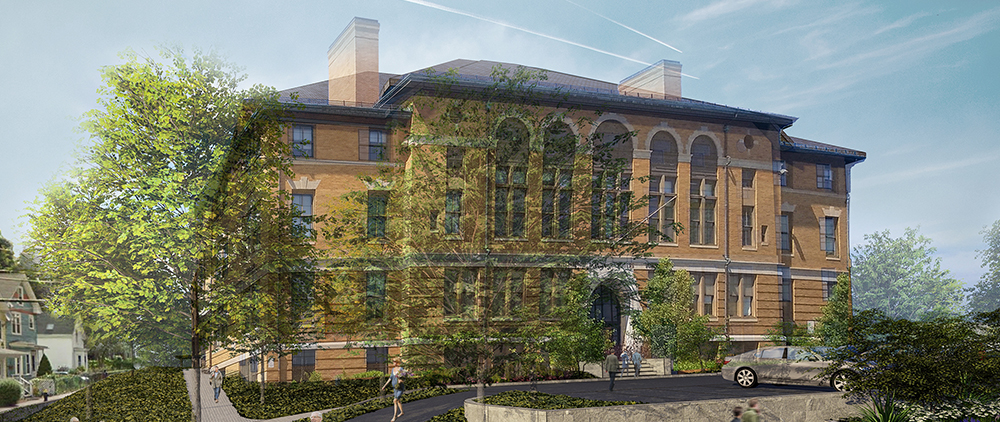
Hyde Park, MA According to mayor Martin Walsh, the former William Barton Rogers Middle School will be transformed into the city’s first designated LGBTQ-supported housing development for seniors. When complete, the $33 million development will preserve the original 1899 building, while creating 74 new income-restricted rental units that will be welcoming to seniors 62 years and older, and specifically welcoming to seniors who identify as LGBTQ. All units will be deed-restricted in perpetuity, and will provide affordable, safe housing for seniors across a wide variety of incomes.
The $33 million project is being led by Pennrose Development and LGBTQ Senior Housing, Inc. who worked extensively with the local community to meet the needs of residents. In addition to 74 affordable rental units designed by architecture and design firm, DiMella Shaffer, the new development will also include gallery space, an arts studio, community rooms, community gardens and recreational space, which will be available to both residents and the surrounding community.
“I’m proud that together with our partners, we’re creating Boston’s first designated LGBTQ-supported senior building at the former site of the Rogers Middle School in Hyde Park,” said mayor Walsh. “As Boston’s residents continue to age, the need for safe, affordable housing that is welcoming to all remains essential. This new development will be an incredible asset to the neighborhood, offering seniors housing, along with community gardens, walking trails, and other community benefits. I look forward to our work ahead to make more of these projects a reality.”
“Pennrose and LGBTQ Senior Housing Inc. are both thrilled and honored to be chosen to redevelop this historic school into a new resource,” said Pennrose Holdings, CEO Charlie Adams. “Our proposal will create senior housing and provide the larger community with many amenities. Hyde Park has been home to many ‘firsts’ and we look forward to continuing to work with the community as we develop the first welcoming and friendly LGBTQ senior housing in Boston.”
“As a long term business owner and resident of Hyde Park I am excited that the Pennrose proposal was chosen for the abandoned Barton Rogers Middle School,” said Pat Tierney Hyde Park resident and the owner of Tierney Realty Group. “This development will do so much for the neighborhood; by beautifying the existing corner, creating commerce for the business district and supplying much needed senior housing for all seniors regardless of their sexual orientation or income level. I consider Pennrose to be a leader in quality senior housing. Let me be the first to welcome such an innovative, creative and Inclusive development to Hyde Park.”
Of the 74 total income-restricted rental units in the new Barton Rogers development, eight will be rented to households of individuals who are homeless or who require rental assistance. Another eight will be deeply affordable units for seniors whose income is between $25,000-$40,000 per year. In addition, 34 units will be available to households earning less than 60% AMI (about $55,000 for a two-person household). The remaining units will be rented to households earning up to 80% AMI (eight units) and 100% AMI (16 units).
The William Barton Rogers Middle School was built in 1899 on 74,000 s/f of land. It was named in honor of William Barton Rogers, a geologist, physicist, and educator who was the primary founder and first president of the Massachusetts Institute of Technology in Cambridge. The original building was expanded twice, once in 1920, and then again in 1934. In the more than 100 years of its operation as a Boston Public School, it served as a high school, and then as a middle school. Before its closure in June of 2015, the Rogers School put an emphasis on the performing arts, and the tenet of inclusivity for all.
“With the housing boom Boston has been witnessing, we need to ensure housing for our seniors, especially for the underserved LGBTQ community,” said Philippe Saad, associate principal at DiMella Shaffer. “Innovative partnerships like this one will serve as a model for opportunity. It paves the way towards integrating older adults in their community by providing spaces that are inclusive and multigenerational by design. This project will also further the city’s age-friendly initiative and Imagine Boston 2030 as we head into 2020.”
Since the start of the Walsh Administration, over 2,000 units of affordable housing for aging citizens have been preserved as deed restricted affordable units, many of which otherwise would have become market-rate units. The city works to identify and help seniors who are being evicted or foreclosed on and come up with solutions that allow them to remain in their homes or be rapidly rehoused in new housing. Since 2014, the city’s program has prevented more than 1,000 of Boston’s seniors from losing their housing and becoming homeless.
In 2018, mayor Walsh updated his comprehensive housing strategy, Housing A Changing City: Boston 2030 to increase the city’s overall housing goal to 69,000 new units by 2030. This goal includes the creation of 15,820 new income-restricted units, which will elevate Boston’s number of income-restricted units to 70,000, while maintaining its ratio of one income-restricted unit in every five units of housing in Boston. Creating 2,000 new units for low-income seniors by 2030 is a specific target within this 15,820 income-restricted unit goal. There are currently 310 units of senior housing in construction, and an additional 350 units, including the 74 at the Barton Rogers School, are in the development pipeline. Mayor Walsh’s 2019 housing security legislative package focuses on measures to protect Boston’s senior renters while expanding upon the work that Boston has done to address the region’s affordable housing crisis by strengthening tools that leverage Boston’s prosperity and create new sustainable opportunities to make Boston a more inclusive and equitable city.
 (1).png)







